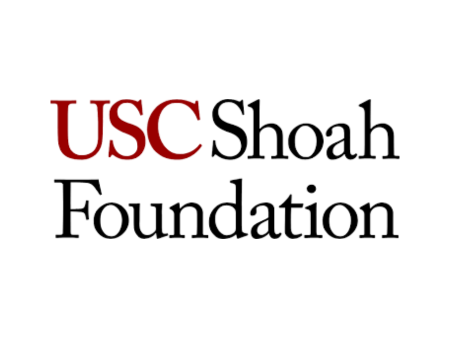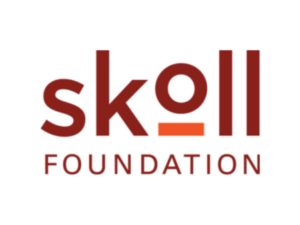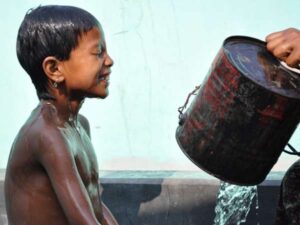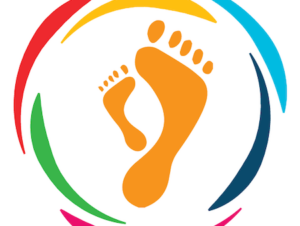The USC Shoah Foundation is a non-profit organization that enables Holocaust survivors to tell their own stories in their own words in audio-visual interviews, preserve their testimonies, and make them accessible for research, education, and outreach for the betterment of humankind.
Andrea Waldron of USC Shoah Foundation spoke with Alec Saelens on April 10, 2024. Click here to read the full conversation with insights highlighted.
Alec Saelens: I’m going to ask you first to introduce yourself and talk about your organization, the work that you do, particularly what is the issue that you’re dealing with and how you’re responding to that.
Andrea Waldron: I work for the USC Shoah Foundation. I’ve been there for eight years. The Shoah Foundation was started in 1994 by Steven Spielberg. When he was in Poland filming Schindler’s List, Steven was approached by survivors on and off the set. It was an open set, and so a lot of survivors were coming up and talking to Steven and the crew, asking about what was going on and what they were filming.
Throughout that process, Steven began to talk to the survivors. Many of the survivors shared with him their experiences during World War II, during the Holocaust. And he was really inspired by those conversations. In particular, one survivor said to Mr. Spielberg, “I had a life before the war, I had a life during the war, and I have a life after the war. And if I were to tell you my story, Mr. Spielberg, that’s the story that I would tell you.” That is one of the many conversations that inspired him to start the Shoah Foundation.
The intent of the Shoah Foundation was to record the audiovisual history of Holocaust survivors and to share them with the world. The original goal was to collect 50,000 survivor testimonies, which they did over a period of about five to six years in 42 languages and 65 countries, which, back in the mid-90s and late-90s, was actually pretty incredible. They were still taking audiovisual testimony on cassette tapes, on VHS, and traveling all around the world to places that people had not been to before and taking testimony from survivors. The mission of the Shoah Foundation has always been to share those testimonies for the betterment of humanity.
We met [the goal of] 50,000 [testimonies] by around 2000. Then we continued to take testimony, but at that point the goal of the foundation shifted. At the time, the testimonies were on VHS. We were starting to digitize them as technology evolved. But the idea was that once you hear from a survivor directly and you experience their story through their lens, you become changed, and so we wanted to share them for education and research and scholarship purposes. The idea really became, how do we get these testimonies out into the world? It’s great that we have them, but we need to get them out there.
So we started the process of digitizing them and indexing them, and we actually hold 11 patents for making our archives searchable down to the minute of testimony. We have more than 70,000 keywords that you can search. You can go into the archive and search by person, place, name, theme; you can search for “hunger,” for anything, and it will surface all of the testimonies where a survivor speaks about those. And you can actually click on the minute of testimony where that survivor talks about [your keyword].
At the time, Google and these things didn’t really exist, so we created a lot of that. The idea was to get it into the hands of researchers and scholars, but what we also realized is that we could use this for educators, and the next phase of the mission after collection was education and scholarship. And we started working with secondary teachers, using curated clips of testimony to help people teach about the Holocaust, but to also understand the real-world consequences when hate goes unchecked.
Today, we’ve reached more than 400,000 educators in 25 countries. We have lessons in more than 13 languages, and we have testimonies now in 45 languages. Teachers can download curated clips of testimony. They can download lessons that are specific to topics like the Holocaust, or resilience, tolerance, othering, any of the things that you might find teachers trying to grapple with in today’s society.
More than 21 million students worldwide at this point have engaged with testimony. We have some of our testimonies available on YouTube. More than 41 million people have engaged with testimony over YouTube, and that’s really the goal of the USC Shoah Foundation: to get eyes on testimony.
Alec Saelens: What makes your approach distinctive from other such initiatives? There’s nothing equivalent to the Shoah, to the Holocaust, but in terms of the research method and research process, I wonder if you could dig into what is particular about the work that you’ve done.
Andrea Waldron: We did decide to expand the archive to other genocidal experiences. The Holocaust is, of course, our largest experience group, but we also have the Armenian genocide, the Rwandan genocide, the Cambodian genocide, the Guatemalan genocide, the Nanjing Massacre, and we also have contemporary collections. The idea that is unique to us is that we do testimony-based education.
A really good example of that is in Rwanda after the Rwandan genocide. Rwanda is actually commemorating the 30th anniversary of the genocide this week. We did a peace education curriculum with some of the organizations there, and we used Holocaust survivor testimony to teach reconciliation and resilience and acceptance to Rwandan middle-school and high-school students, because [after] the Rwandan genocide, the perpetrators and the victims’ families went back to living side-by-side in the communities.
While Rwanda has had its own reconciliation efforts, the Peace Education Program allowed students to learn from Holocaust survivors about how they were able to overcome having lived through the tragedy, through the Holocaust–but then also, how did they build their lives after? What did that look like? How did they find the resilience and how did they accept and move on?
You can’t compare suffering from one genocide to the other, but I think you can look at what is similar and what is unique about all of them and understand the manifestations of hate. How do we disrupt that? How do we teach youth, not even just about tolerance and acceptance, but about moving beyond tolerance and thinking about empathy and truly caring for the situation of one another, whether it be somebody with a refugee status, somebody who’s experiencing antisemitism or [anti-]Black racism?
Alec Saelens: How do you measure the success of your work, and particularly what kind of evidence do you use to demonstrate the progress that you’re making?
Andrea Waldron: I think measuring social impact and behavior change is always difficult. It’s probably the most difficult impact to measure.
We do it both qualitatively and quantitatively. One of the things that we do in our educational programs through secondary education is first look to evaluate whether or not students’ understanding of the historical context of what happened has increased. So we do pre and post surveys, but we also look to understand the nuances of the history with our students. Are they understanding it? Does it resonate with them? Are they able to identify it within their own lives and draw those parallels? That’s the qualitative piece that we look at.
We also follow our students longitudinally. What we’re trying to do is give students the agency to make change, to [be] the upstanders in their communities, so that when they see identity-based hate, whether it be antisemitism or some other form, are they willing to use their voices to stand up? What we found is that when they have the education and the foundation and when they’ve seen others do it, whether it be a Holocaust survivor, a Rwandan survivor, Guatemalan survivor, the fact is that they do and that they carry this forward in their lives from high school through college.
So we do longitudinal measurement and evaluation. We do it with educators as well. We do a lot of professional development with educators both here and around the world. And if you look at what happened in Charlottesville in 2017, one of the educators, the teacher of the student who drove his car into the rally, said the student had been verbalizing these things in class, but as an educator, he didn’t have a way to address them. He didn’t have those tools, so they didn’t address them. So what we try to do is give teachers tools to surface these things, because we know that students are grappling with these things.
We’re giving teachers tools to surface these conversations, but also to extend those conversations at home in the community with family members as a whole. We do measurement and evaluation with our educators, with our students. We track behavioral change over time with longitudinal studies, and then we do open-ended evaluations to really understand what are the changes that students are seeing within themselves and what are the changes that teachers and administrators are seeing in the students as well.
Alec Saelens: What kind of evaluations do you do? Is it survey-based with teachers? Can you explain from the student’s perspective how that happens?
Andrea Waldron: It’s both survey-based and interview-based longitudinal follow-up with students, [which is] as difficult as you can imagine. And there are privacy issues.
Alec Saelens: One of the predominant challenges in this space is raising money and getting funding to support the work. Beyond that, what are the issues that you grapple with? And what are the ways that you’ve managed to circumvent those issues or find solutions to address them?
Andrea Waldron: Hate is ever-evolving. We recently took an experiential learning trip with student-athletes from the University of Southern California, where the USC Shoah Foundation is based, and we did a week intensive on antisemitism and what it looks like today, the origins of antisemitism, how it manifests, how it looks different today than it did before.
We then took them to Poland and we showed them what Jewish life and culture looked like pre-war in the Jewish corridor. We took them to Auschwitz and shared with them what the unchecked manifestation of hate looks like. The learnings from that were incredible. These were predominantly student-athletes, students of color, mostly non-Jewish. We had one student who said, “I didn’t know that antisemitism still existed.” We had other students who said, “I didn’t know what antisemitism looked like today. And as I reflect upon my experience these past two weeks, I realized that I have engaged in Holocaust distortion and denial unknowingly because I didn’t truly understand what it was.”
Many types of hate have evolved, so people don’t even know exactly what it looks like anymore. I think antisemitism in 1938 is very easy to identify. I think antisemitism in 2024, not so much. And it’s the nuances that you see, the microaggressions, the not understanding the context of it. And how do we give people agency to speak out against it and the tools and resources to engage in civil discourse? Because whether it’s antisemitism or other forms, identity-based hatred has become hyper-politicized. I think just helping people to see that it’s about human beings is our biggest challenge.
At the end of the day, it’s not that we necessarily have to agree, but that we can see the humanity in each other’s position and that we can agree to accept and that we can have empathy. It’s really to come to each other as individuals and to engage in civil discourse.
Alec Saelens: How do you work to advance systems change, and how do you think about it? What is your theory of change? What do you contribute to making change happen, and what do you think other actors in this space can contribute?
Andrea Waldron: It takes all of us working towards the goal for systems change to happen. We are celebrating our 30th anniversary, and as we look to the next 30 years, we are trying to work at a systems-level secondary education. We offer education from kindergarten all the way through universities, and that’s one piece of it, but we have to move beyond that.
So [we’re] really looking at how antisemitism and hate manifest online. Where are they coming from? How do we engage with policymakers? How do we engage with social-media companies? How do we engage with journalists, who not only narrate the stories about what’s happening but also direct people in some ways how to feel about what’s happening? How do we work with them? How do we train them? How do we give them the stories of survivors so that they, too, are able to see the humanity and report on them ethically and create policies that benefit the people that they are elected to represent? Systems-change takes all of those pieces.
Holocaust education, as we are seeing, has not been the panacea to ameliorate antisemitism as I think many of us thought it could have been. I think a lot of us were lulled into a sense of we’ve done a really great job in the last 30 or 40 years, and I think what we’re seeing is it was always there and it’s manifesting very differently now. You’re seeing an unprecedented rise in antisemitism. And a lot of people will say that antisemitism is the canary in the coal mine for other types of identity-based hate. And if that’s true, I think we are in a very scary place and time.
When you look at research and scholarship, you’re looking at what is going to happen with identity-based education, with Holocaust education, with social-emotional learning in the next five, 10, and 15 years. And if we don’t invest in research and scholarship right now, we’re not going to be able to transform education. That’s one area we’re investing in heavily. In some places, research and scholarship in these areas has actually gone down, and so now it’s our turn to lift it back up again.
That means continuing to take testimonies, whether it be victims of contemporary antisemitism, anything post-1945, whether it’s the relationship between the Black and Jewish communities, or civil rights, or social justice–all of these things that come together. How do we record these stories and these life histories and these testimonies and bring them to researchers and scholars who can lift these things out and then translate them into effective and educational practices for students and for educators, and which can create the social-behavioral change that we want to see? How do we put them together for policymakers so that they can see what’s happening in their own spaces?
We worked with UNESCO and with the UN around a contemporary antisemitism collection starting in about 2017. We took testimony in seven different countries across Europe. We took the findings from people who had either witnessed or been victims of contemporary antisemitism. We created the content and we sent it back, and what we heard from a lot of the policymakers is, “We knew that there was a little bit of [these] things happening in our country. We didn’t know that it was widespread. We did not know it was at epidemic proportions.”
So some of it was just awareness-building and outreach and providing forums in communities for people to come together and problem-solve around what’s happening. To have open dialogue without being afraid of saying, “It’s happening in my community. It’s happening in my country. It’s manifesting in this way,” because there is a hyper-polarization around it in terms of blame. It’s not about blame. We just really want to solve the problem.
The people who are spewing hate are very compelling. They have compelling content. It’s online. How do we disrupt that? How do we provide counter-content and counternarratives that are equally compelling to young people who are being radicalized online, who are learning about the history of our world and of hate and of different societies in ways that are not helpful and not meaningful? How do we combat that? And how do we use predictive AI and other technologies to do that in a way that takes the human capacity out of it and makes it more automated? And then how do we engage the big social-media giants, the dark spaces, and policymakers to put this content forward?
The interesting thing is that there are so many different organizations that are working in these spaces, whether it’s on traditional social media channels, news sites, subreddit groups, the dark web, wherever it is. You have the ADL talking about, here’s how much hate is happening online. And you have other places that are saying, here’s where it’s originating or here’s what it looks like.
But none of them are really speaking to each other, and none of them have a shared platform where they can bring this information together so that solutions can be born from that. That is the next challenge. What I think we’re missing is a place where [we can] convene and bring them all together so that [we] can share information. We need a place [where] we can understand what’s happening and bring solutions forth in it in a collaborative way.
We also are witnessing the unprecedented aging of our Holocaust survivors, and we’re facing a time when we no longer have Holocaust survivors with us. And so what does that look like? What is the future of Holocaust memory? But also, what is the future of a generation that cannot have an interaction with a human Holocaust survivor? What does that look like?
We have something called Dimensions in Testimony, which is an interactive interview with a Holocaust survivor, where you can ask questions, and the interview, using AI and natural language processing, will answer. It’s the closest thing that we can simulate [a conversation]. But evaluation shows that interactive conversation is where the greatest amount of behavioral change happens. That’s where students really start to question how they think and what they think, and they start to understand. Once we lose our survivors, how are we going to continue that for future generations?
Alec Saelens: You mentioned that different actors are operating on similar issues but don’t really talk to one another, and therefore there’s no strength in numbers and no collaboration to create a multiplier effect and maximize the response. What do you think is needed or what have you seen work to break down those barriers and those silos?
Andrea Waldron: One of the biggest issues is that people are competing for funding. So in some ways, we see people that should be our partners as our competitors. When you get philanthropists or organizations like the Skoll Foundation who have a genuine interest in learning from the grantees that they fund and bringing those grantees together to work collaboratively, I think that’s where you see one of the greatest solutions.
The other thing is you’re seeing a lot of research, but there’s not a pipeline to put that research into practice and then evaluate that practice and figure out how to retool and how to learn from our failures. It’s fail forward. We don’t have the answers, and we’re not going to know the answers until we can really engage in this work.
There are a few centers out there that are looking at stuff like this. Right now, we are launching a Countering Antisemitism Laboratory. The idea is to bring researchers and practitioners together to build a platform that can share, engage in dialogue, and build solutions together. If we can open up those dialogues with the organizations that are leading their efforts in different spaces, if we can bring them together, if we can find funders who are willing to fund that collaboration without saying that you have to do or achieve A, B, or C, but [with] collaboration being the success in and of itself, I think that’s when you will start to see real change and real solutions come to the forefront.
Alec Saelens: What are the teachable lessons from the work that you’ve been doing that you think that the field should hear, whether it is other people who are working in this space, funders, or anyone else?
Andrea Waldron: The biggest lesson is that change is possible. Sometimes it is slow, and it is hard, and sometimes we think we’ve done more than we have, and then the reality hits us that we haven’t come as far as we would’ve liked. But the power of storytelling, the power of the human experience, is unparalleled, and it is still our greatest weapon against hate. The human experience is our greatest weapon, and if we can share with each other a way to see our collective humanity, that is when I think we will truly achieve change.
Alec Saelens: That was a great note to finish on. Thank you so much for your time.
Click here to read the full conversation with insights highlighted.
Alec Saelens is a former journalist who supports SJN and its partners track solutions journalism’s impact on society and the industry. In his former role, he researched and consulted on the connection between solutions journalism and revenue. He is co-founder of The Bristol Cable, the UK’s pioneering local media cooperative. Before SJN, he was a researcher and coach for the Membership Puzzle Project and an analyst for NewsGuard.
* This interview has been edited and condensed.
Read about other social innovators working with Holocaust survivors.







